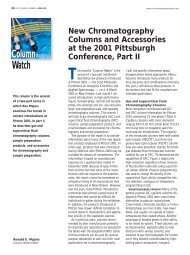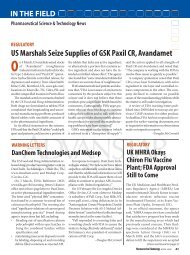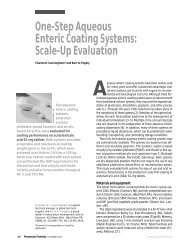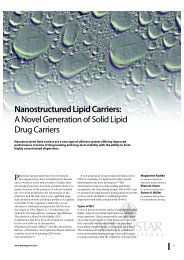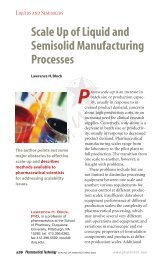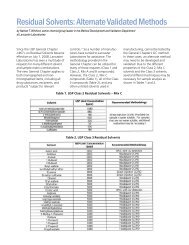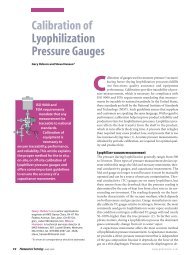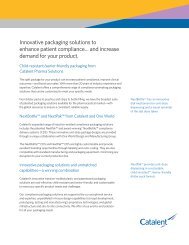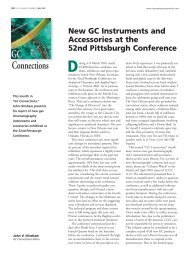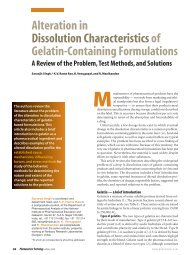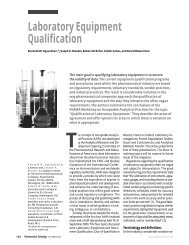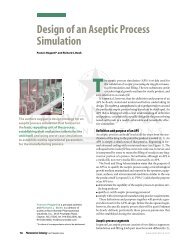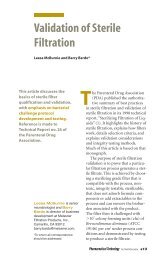The Role of the Column in Preparative HPLC - Chromatography ...
The Role of the Column in Preparative HPLC - Chromatography ...
The Role of the Column in Preparative HPLC - Chromatography ...
Create successful ePaper yourself
Turn your PDF publications into a flip-book with our unique Google optimized e-Paper software.
420 LCGC NORTH AMERICA VOLUME 22 NUMBER 5 MAY 2004 www.chromatographyonl<strong>in</strong>e.com<br />
Figure 2: Calculations for scale-up method development.<br />
phase might have a slightly larger coverage<br />
and a C4 an even larger coverage still. So<br />
on some reversed-phase pack<strong>in</strong>gs, <strong>the</strong> coverage<br />
<strong>of</strong> a shorter cha<strong>in</strong> alkyl phase actually<br />
can exceed that <strong>of</strong> a C18 bonded phase.<br />
Thus, <strong>the</strong> amount <strong>of</strong> available carbon for<br />
<strong>the</strong> hydrophobic <strong>in</strong>teraction with <strong>the</strong> analyte<br />
actually might provide a better measure<br />
<strong>of</strong> surface coverage than <strong>the</strong> alkyl<br />
cha<strong>in</strong> length. Most manufacturers provide<br />
<strong>the</strong> level <strong>of</strong> carbon coverage for <strong>the</strong>ir particular<br />
reversed-phase pack<strong>in</strong>gs. In addition<br />
to bonded-phase density, <strong>the</strong> density <strong>of</strong> <strong>the</strong><br />
particles <strong>in</strong> <strong>the</strong> packed column also can<br />
affect <strong>the</strong> sample capacity.<br />
Resolution is seen as <strong>the</strong> most important<br />
factor <strong>in</strong> analytical chromatography and is<br />
equally important <strong>in</strong> preparative chromatography.<br />
However, because columns<br />
frequently are overloaded <strong>in</strong> preparative LC<br />
and peaks are broadened, <strong>the</strong> selectivity <strong>of</strong><br />
<strong>the</strong> separation <strong>of</strong>ten is a very important<br />
factor <strong>in</strong> successfully us<strong>in</strong>g preparative LC.<br />
If <strong>the</strong> selectivity between two sample components<br />
that are to be isolated is high, one<br />
can overload <strong>the</strong> column to a much greater<br />
extent than if <strong>the</strong> selectivity is low. Thus,<br />
choice <strong>of</strong> stationary phase can be critical to<br />
provid<strong>in</strong>g <strong>the</strong> best selectivity for <strong>the</strong> components<br />
<strong>of</strong> <strong>in</strong>terest. Table I provides some<br />
rough guidel<strong>in</strong>es on sample capacity for a<br />
typical reversed-phase column as a function<br />
<strong>of</strong> a (selectivity factor). <strong>The</strong> actual<br />
sample capacity for your <strong>in</strong>dividual sample<br />
components might have to be determ<strong>in</strong>ed<br />
by trial-and-error measurement.<br />
Particle Size and <strong>Column</strong><br />
Dimensions<br />
Particle size is an important parameter for<br />
analytical <strong>HPLC</strong>. Generally, smaller particle<br />
sizes allow greater efficiency and permit<br />
<strong>the</strong> use <strong>of</strong> shorter columns to <strong>in</strong>crease separation<br />
speed. In preparative chromatography,<br />
<strong>the</strong> particle size is important, but <strong>the</strong><br />
column <strong>of</strong>ten is used <strong>in</strong> an overloaded<br />
state, <strong>the</strong> smaller and more expensive particles<br />
<strong>of</strong> 1.8-, 3.0-, and 3.5-mm average<br />
diameters that are used <strong>in</strong> analytical<br />
columns generally are not used <strong>in</strong> largerscale<br />
preparative columns. If a sample is<br />
very complex with poor resolution (and<br />
selectivity) among compounds <strong>of</strong> <strong>in</strong>terest<br />
and overload<strong>in</strong>g sometimes is difficult,<br />
<strong>the</strong>n 5-mm particles frequently are used.<br />
For well-resolved samples, larger particles<br />
<strong>of</strong> 7 and 10 mm can be used. Sometimes,<br />
even larger particles are used, but a trade<strong>of</strong>f<br />
<strong>of</strong> yield, purity, and throughput must be<br />
achieved. Because pressure drop is <strong>in</strong>versely<br />
proportional to <strong>the</strong> particle diameter<br />
squared, larger particles give lower pressure<br />
drop, allow<strong>in</strong>g higher flow rates, which <strong>in</strong><br />
turn <strong>in</strong>creases <strong>the</strong> throughput <strong>of</strong> preparative<br />
columns. Generally, <strong>the</strong> cost <strong>of</strong> pack<strong>in</strong>g<br />
material is <strong>in</strong>versely proportional to<br />
particle size, so <strong>the</strong> larger particles usually<br />
Table II Typical operat<strong>in</strong>g conditions for columns <strong>of</strong> various dimensions<br />
Parameter<br />
<strong>Column</strong> Diameter*<br />
Length (cm) 4.6 mm 9.4 mm 21.2 mm 30 mm 50 mm<br />
5<br />
10<br />
15<br />
25<br />
1 mg 3–5 mg 30–50 mg 80–100 mg 250–300 mg<br />
4–6 15–20 80–90 200–250 500–700<br />
8–10 30–40 140–160 300–350 800–900<br />
12–15 50–60 200–250 475–525 1200–1400<br />
Injection volume (mL) 10–20 50–75 350–400 700–800 1500–2500<br />
Flow rate (mL/m<strong>in</strong>) † 1.0 4.2 21.2 42.5 118<br />
* Blue shaded area represents approximate sample mass that can be <strong>in</strong>jected onto a column <strong>of</strong> <strong>the</strong>se<br />
dimensions.<br />
† Flow rate required to keep l<strong>in</strong>ear velocity and separation time <strong>the</strong> same.



